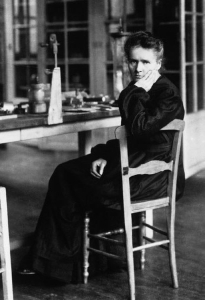

Birth: November 7, 1867
Death: July 4, 1934
Specialty: physics/chemistry
Major Contributions:
Developed the theory of radioactivity
Discovered two elements: polonium and radium
Created mobile radiography units during WWI
Image Source: Wikimedia Commons
Marie Curie was born in 1867 in Warsaw, Poland but left her home country in 1891 to study in Paris, where she completed most of her achievements, including the development of the theory of radioactivity, discovering the elements polonium and radium, and winning Nobel prizes in both physics and chemistry.
Her road to success was difficult, but she was determined and intelligent. Women were not allowed to enroll in traditional higher education at the time, so she studied at the Flying University, which was an underground institution in Poland. In the 1890’s, she earned master’s degrees in physics and mathematics from the University of Paris. She intended to continue her work in her home country. However after being denied a place at Krakow University due to her gender, she returned to Paris to pursue her PhD, and married Pierre Curie shortly after.
As her studies evolved to include uranium, Curie began to make her mark in the scientific world. While her husband soon joined her investigations, she was always clear about establishing her own credits and contributions to their work. In 1898, the Curies published papers announcing the discoveries of polonium and radium, and coining the term radioactivity. In 1903 Curie became the first woman to receive a doctoral degree in France and was the first woman to be awarded a Nobel Prize. She was later awarded the prize in Chemistry, making her the first person to win two Nobel prizes.
After Pierre’s death in 1906, Marie was offered his place at the University of Paris and became the first female professor at the school. During World War I, she developed mobile radiography units to assist battlefield surgeons. It is estimated over one million soldiers were treated in these units.
In 1934, Curie succumbed to aplastic anemia, which was caused by exposure to the radioactive elements she discovered and studied. Though her life was cut short, she left a lasting legacy. She founded the Curie Institutes in Paris and Warsaw, and her family has continued her work in the generations since her death.
Written by Mary Ratliff
Sources:
American Institute of Physics: Marie Curie and the Science of Radioactivity
See Also:
